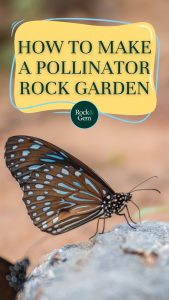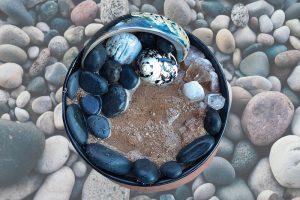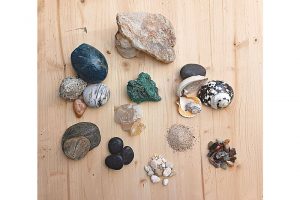
Learn how to make a pollinator rock garden to provide pollinators with useful habitat and the minerals they need to thrive.
It’s no secret that nature’s pollinators are declining. There are many ways humans are attempting to address this issue, but one of the easiest is by hosting a pollinator habitat with rocks. It may come as a surprise to learn that landscaping with rocks can help. Rocks? Yes.
Even though butterflies and bees don’t seem to have much need for rocks, there is an interesting connection. Certain rocks not only attract insects by their color, but they also contain minerals that pollinators need.
In Search of Minerals

If you notice groups of butterflies gathering at unexpected places, such as on gravel roads, sandy paths, beaches and mud puddles, even on decaying vegetable matter and carrion, it is because they are seeking dissolved salts and minerals that are not found in their natural diet. Therefore, they must hunt outside their foraging habits.
Seeking mineral additions is not at all uncommon. Elephants, parrots and other wild creatures seek outside sources for dietary minerals, usually in places like mud pools, lake shores, exposed dirt banks or in decaying matter.
Pollinator Behavior
This same behavior holds true for insects, especially butterflies, moths and other pollinators. Often you may see bees clustering around coleus leaves, sleeping and hanging onto the plant in hopes of maintaining enough food. According to researchers, bees do sleep, sometimes they fall asleep in flowers or sit stationary for hours on natural rock formations.
Butterflies are a bit pickier. They actively seek minerals to survive.
Butterflies enjoy ‘puddling,’ where large numbers of tiger swallowtails, white admirals, sulfurs, skippers, crescents, northern pearly eyes, wood nymphs and eyed browns gather.
Sometimes moths who require a mineral or salt fix can be spotted puddling too.
A fun fact is that mostly male butterflies are the ones puddling. This behavior is found in areas where minerals are needed for reproduction. The minerals needed for reproduction are carried primarily in the insect’s sperm, so male butterflies must ingest enough essential minerals, such as those found in limestone, sandstone and gravel.
Attracting Pollinators
One of the most attractive methods to draw pollinators is to supply them with stable resting places where they feel they can land and sit awhile during their eating or migration periods. Rocks can be just the ticket. What holds their attention is not only the color of rocks but the minerals the rocks provide.

Rocks that attract include jasper, quartz, turquoise and obsidian. Rock colors that attract bees are white, yellow, purple and blue. Butterflies are attracted to colors such as orange, red, yellow and purple.
Morning dew condensing on rocks provides moisture to attract butterflies that fly down from the treetops to gather their requirements. They can be seen perching in the sand, tasting the soil from rocks rich in salts and minerals.
Sedimentary rock contains the required minerals for butterfly reproduction. Damp sedimentary rock such as sandstone and limestone offer mineral material as it becomes dissolved in water suspended in the rock. Providing these rocks is a way to help pollinating insects survive and can make useful additions to your pollinator garden in other ways, as well.
DIY Puddling Areas
Making a ‘puddling’ area in your garden, especially near nectar-producing flowers, is a simple and effective way to provide minerals and salts and a puddling place can be assembled with very little effort.

Begin with a shallow ceramic container, a birdbath or terra cotta dish, then add damp sand or gravel, leveling it to the brim of the container. One good design is to place sand in one half of the dish and gravel in the other and finally add the sedimentary rock, selecting the color of your choice. A small amount of compost or composting manure can increase the mineral and salt content and include some pieces of over-ripe fruit.
This combination can make the area hard to resist. Pollinators will collect to gather the minerals and salts from the base material and the sedimentary rock.
Keys to Making a Good Puddling Container
There are four essential keys to keep in mind in making a puddling container. With these steps in mind, the likelihood of the pollinators finding your creation is high.
1. The sand, gravel and porous rocks you are using must be kept damp.This is a critical element since having the minerals suspended in liquid is the only way a butterfly can make use of them.
2. There can be no standing water in the puddling station you are making.Butterflies do not like open water, so any pools of water collecting in your puddling station will be a discouraging factor.
3. Location. Location. Location. Take the time to find a consistent sunny spot, preferably with some sort of windbreak. It is hard to feed or rest when the insect’s body is being buffeted by wind.
4. Sand, gravel or mud must be taken from naturally occurring sources such as beach or backyard sand or gravel from natural areas. Artificially processed sand and gravel you might find at the store may not contain the minerals the pollinators need.
Tips for Success

Pollinators require places to rest, and perching on tree or plant branches as a bird might do, is not possible, so providing a warm flat colorful rock to serve as a place to pause and recoup energy, adds to the lure of your puddler.
Color is a major factor in the overall effectiveness of a puddling station.
Flowers, blooming shrubs, herbs and vegetables are important both as food sources and as beacons. If blooms are not abundant or have not yet emerged, use colorful rocks as they can act as a magnet to insect visitors.
Rocks can also add to the visual charm of a pollinating garden. Making your puddling station with all three types of rocks -damp sedimentary rock for minerals, flat rocks for rest and recovery or regroup stations, and colorful rocks -adds beauty to your spring, summer, and fall gardens.
Different Locations
Once you create a puddling station, you can create another in a different section of your garden. There is no limit to the stations you can offer the pollinators. You will be helping them survive and protecting them and assisting them to increase in numbers. When pollinators hibernate or move away from your garden, continue to care for your puddling station. Keep the station clean and if necessary, replace the rocks with new colors in hope of attracting young pollinators when spring arrives the following year.
This story about how to make a pollinator rock garden previously appeared in Rock & Gem magazine. Click here to subscribe! Story by Anita B Stone and B. Burns, Ph.D.












